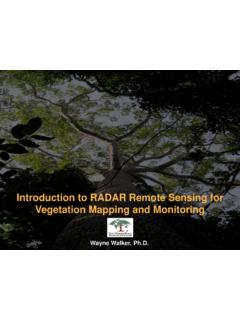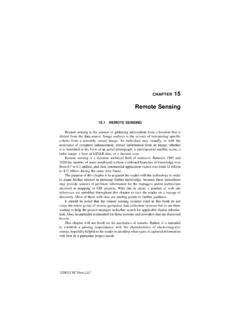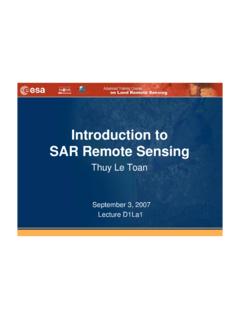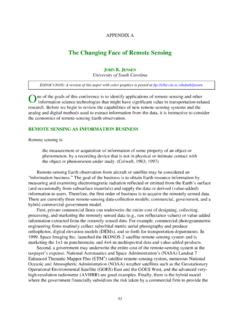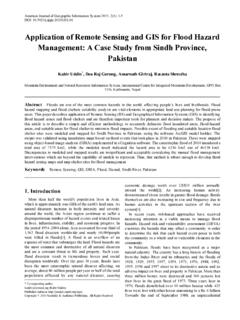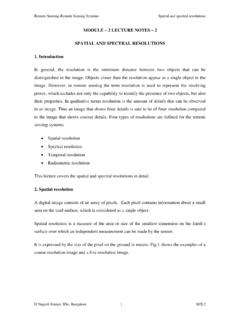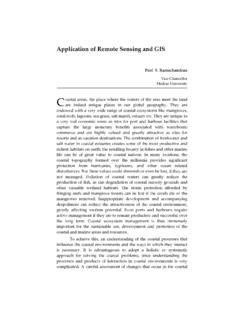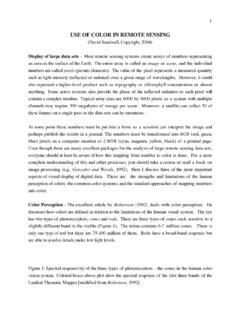Transcription of Remote Sensing Applications at the
1 Remote Sensing Applications at the State and Local Level Report of a User Workshop February 23, 2001 Lamont Doherty Earth Observatory Palisades, NY Sponsored by the Socioeconomic Data and Application Center (SEDAC) Center for International Earth Science Information Network (CIESIN) Columbia University Report of the Workshop on Remote Sensing Applications at the State and Local Level ii The User Workshop on Remote Sensing Applications at the State and Local Level was sponsored by the Socioeconomic Data and Application Center (SEDAC) of the Center for International Earth Science Information Network (CIESIN) at Columbia University. The Workshop home page can be found at The Center for International Earth Science Information Network (CIESIN) was established in 1989 as an independent non-governmental organization to provide information that would help scientists, decision-makers, and the public better understand their changing world.
2 In 1998, CIESIN relocated from its original home in Michigan to become part of Columbia University s Earth Institute. CIESIN focuses on applying state-of-the-art information technology ( , computer science, data archiving, geographic information systems, and Remote Sensing ) to interdisciplinary problems at the intersection of human and environmental systems. CIESIN at Columbia University Box 1000 61 Route 9W Palisades, NY 10964 USA Tel. +1-845-365-8988 Fax: +1-845-365-8922 Web: Report edited by Francesca Pozzi, CIESIN. Work supported by the National Aeronautics and Space Administration, Goddard Space Flight Center under contract NAS5-98162. The opinions expressed here are those of the participants and editor and are not necessarily those of CIESIN or NASA. Copyright 2001 The Trustees of Columbia University in the City of New York Report of the Workshop on Remote Sensing Applications at the State and Local Level iii Executive Summary The Workshop on Remote Sensing Applications at the State and Local Level was organized by CIESIN s Socioeconomic Data and Application Center (SEDAC) to address issues of availability and the needs for remotely sensed data products by local users.
3 The workshop took place at Columbia s Lamont-Doherty Earth Observatory, in Palisades, NY and was attended by about twenty representatives from local and state governments and non-governmental organizations in New York and New Jersey. The objective was to solicit input from potential users of geo-referenced data products derived from remotely sensed imagery, in terms of specific products needed for on-going activities and the exploration of new Applications . The increasing availability and accessibility of new technology and data for local governments and agencies are proving helpful for day-to-day decision-making processes. In particular, remotely sensed data and Geographic Information Systems have been increasingly used together for a vast range of Applications , ranging from land use/land cover mapping to emergency management to characterization and monitoring of environmental and human health conditions.
4 SEDAC has been working with five sets of Landsat 7 ETM+ images covering parts of New York, New Jersey and Connecticut, acquired during the fall 1999 and the winter 2000. Using the above images, SEDAC s staff have explored ways to develop new and innovative products that might be useful for a wide range of Applications within local and state governments. Some of these prototype products were presented at the workshop in order to get feedback from potential users about general usefulness, specific Applications of Remote Sensing products for local governments, and specific issues users would like to see addressed by these products. The two prototype data products presented were (i) a tailored land cover/land use classification and (ii) a greenness map. The discussion focused on usefulness of such products for a variety of Applications , such as landscape assessment, environmental and health conditions monitoring, urban sprawl and urban/vegetation change studies.
5 This led to discussions of specific Applications that local governments and agency are currently involved with and interested in using, with particular emphasis on different sensors and their resolutions. Using an evaluation form distributed the same day, participants provided helpful comments in terms of specialized classifications they would like to have, time frames for image acquisition, and data processing and integration with other data sets. Although there was an agenda item on mechanisms for data sharing and models for collaborative work between governments and organizations, those topics were not discussed in depth, given the differences in interests that emerged during the workshop and the possible difficulties in coordinating such different activities. Such discussions seemed more likely to develop in the future through individual collaborations rather than through a broader group or consortium.
6 Report of the Workshop on Remote Sensing Applications at the State and Local Level iv TABLE OF CONTENTS 1 Introduction .. 1 2 Prototype Data Products Discussion .. 2 Tailored land cover/land use classification.. 2 Background .. 2 7 Vegetation Fraction Index and Urban/Vegetation Change 8 Background .. 8 12 3 Other Applications and Integration with Relevant Data sets .. 13 13 Landscape Assessment .. 13 Air 14 Water quality .. 14 Floodplains mapping and Emergency Management .. 14 Health 15 Integration with Relevant Data sets .. 16 Annex 1. Workshop 17 Annex 2. List of 18 Annex 3. Background 20 References .. 26 1 1 Introduction The Workshop on Remote Sensing Applications at the State and Local Level was organized by CIESIN s Socioeconomic Data and Application Center (SEDAC) to address issues of availability and needs for remotely sensed data products among local users.
7 Specifically about twenty representatives from local and state governments and non-governmental organizations in New York and New Jersey attended the workshop to discuss the development of tailored Applications using remotely sensed imagery. SEDAC developed prototype data products using Landsat 7 ETM+ imagery, such as a tailored land use classification and a greenness map (the latter being a simpler version of the Vegetation Fraction Index calculated for New York City by Chris Small). The objective was to solicit input from potential users of geo-referenced data products derived from remotely sensed imagery, in terms of specific products needed for on-going activities and exploration of new Applications . The possibility of forming local and regional collaborations to purchase and share imagery and other data resources was also on the agenda (see Annex 1 for the Agenda and Annex 2 for the Participants list).
8 The increasing availability and accessibility of new technology and data for local governments and agencies is proving helpful in day-to-day decision-making processes. In particular remotely sensed data and Geographic Information Systems have increasingly been used together for a vast range of Applications , spanning from land use/land cover mapping to emergency management to characterization and monitoring of environmental and human health conditions. The higher spatial and spectral resolutions, more frequent coverage and increased availability of new sensors will bring Remote Sensing to a more accessible level within local and state governments and help them deal with several issues in regional planning, resource management, public health and environmental protection. The workshop s objectives were: To examine the prototype data products and discuss the possible uses for local application in terms of Land Cover/Land Use and Vegetation change detection; To discuss other potential Applications , such as emergency management, flood mapping, air and water quality monitoring and related issues of scale and timing; To discuss other relevant data sets and their integration with remotely sensed data; To discuss other satellite data products and possible mechanisms for data sharing.
9 This reports provides a summary of the workshop presentations and discussions. Section 2 describes the discussion on prototype data products, including background material and comments from workshop participants. Section 3 summarizes the discussion on specific Applications and integration with other data sets. Finally, Annex 3 provides background information on Landsat 7 ETM+ and other Remote Sensing satellite and sensors. Report of the Workshop on Remote Sensing Applications at the State and Local Level 2 2 Prototype Data Products Discussion SEDAC has been working with five sets of images covering parts of New York, New Jersey, and Connecticut, acquired during the fall of 1999 and the winter of 2000. The images were collected by Landsat 7 using the Enhanced Thematic Mapper Plus (ETM+) sensor (see Annex 3 for more information on Landsat and other satellites and sensors).
10 The spatial resolution (ground cell or pixel size) varies between 15 and 60 meters and allows detection and mapping of quantities such as vegetation abundance and health, presence of standing water, forest clearing, agricultural usage and other land cover changes. Using the above images we explored several ways of making use of the high-resolution panchromatic band and the improved thermal band, and of developing new products. Some of these prototype products were presented at the workshop, in order to get feedback from potential users about general usefulness, specific Applications of Remote Sensing products for local governments, and specific issues users would like to see addressed by these products. The advantage of having such user-specific products is that they will be developed according to local government needs, they will be compatible with higher resolution data sets already collected and available at the local level, and they will allow a better understanding of dynamics and features that can be integrated in decision-making processes.

